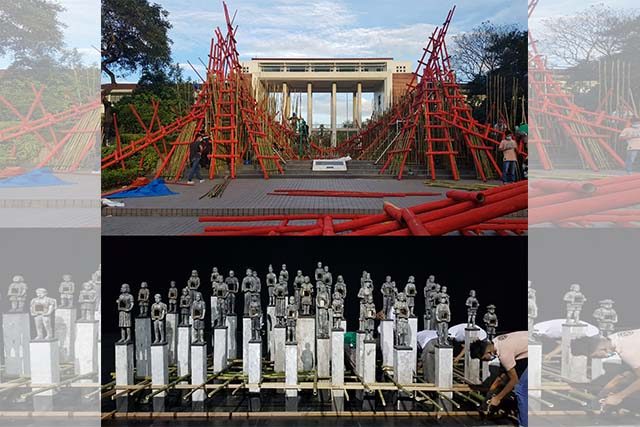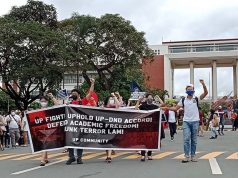
A celebrated visual artist installed a form of barricade made of repurposed materials at the University of the Philippines-Diliman over the weekend to commemorate the 50th anniversary of the 1971 Diliman Commune.
Abdulmari “Toym” de Leon Imao, also an alumnus of the university, announced via Facebook last Sunday that two installations were set up within the campus. These are:
- “Barikada” – A looming red structure made of bamboo and old chairs placed at the Quezon Hall and the University Avenue
- “Desaparecidos” – A display of small human sculptures standing on pedestals placed at the UP Theater
Imao also attached a side-by-side photo of these art works in his Facebook post.
“It’s been a fulfilling weekend setting up these two installations in UP Diliman. Still, much work to be done for these works in progress to be ready in time for the commemoration of the 50th anniversary of the 1971 Diliman Commune on Feb 1 to 9, 2021, when we retell stories from that pivotal period in the history of the UP student movement during the Marcos Dictatorship through various online platforms,” the artist said.
Imao is set to launch these exhibits during UP’s cultural festival called “Engkwentro: UP Diliman Arts and Culture Festival 2021,” on February 1, according to the page of UPD’s Office for Initiatives in Culture and the Arts.
The Diliman Commune is a week-long uprising between UPD students, faculty members and the local authorities that took place from February 1 to 9, 1971.
Members of the UP community then challenged members of the Quezon City Police and the now-dissolved MetroCom troops because of their intrusion into the campus.
Activists considered this as one of the precedents for the now-terminated accord between UP and the military in 1989 wherein the military and the police are prohibited from entering the campus unless granted permission by the school officials and during emergency cases.
The Department of National Defense ended the longstanding accord on January 15, citing allegations of UP campuses as recruitment grounds for communist rebels.
Subject to different interpretations
In another post on Monday, Imao explained that the “Barikada” visual art work was made from repurposed materials such as old pieces of furniture, bamboo stems and lighting.
He quipped that they did not use millions of money, citing previous anomalies and controversial projects of the national government.
“‘Yung installation sa UP na ginagawa po namin ay yari sa mga repurposed materials gaya ng mga condemned UPD furniture, mga kawayan mula sa pailaw ng nakaraang taon at mga gamit na galing sa installation nung February 2019 bago magkapandemya,” Imao said.
“Hindi po siya gawa sa 50 million peso na kaldero, 389 million na dolomite, o mula sa 15 billion na pondo ng PhilHealth (ay nasali),” he added.
Being an art form, the sculptor noted that the red barrier-like piece is subject to different interpretations.
People can perceive the huge structure as “pick up sticks,” an old school children’s game, or red incense.
“Pwede rin naman sabihin na isa siyang kumpol ng Pick Up Sticks (old school na laruan ng mga titos/titas) o yung mga pulang insenso na itinatarak sa mga templo. Kung yun po ang rehistro sa inyo, go lang po tayo,” Imao said.
For Imao, however, the artwork is a remembrance of a significant part of UPD’s history during the Marcos dictatorship.
“Kung kami ang inyong tatanungin, isa po itong paraang biswal ng paggunita sa isang makabuluhang yugto sa kasaysayan ng isang institusyon at ang kanyang komunidad na mulat at handang ipaglaban ang karapatan at tama laban sa isang diktadurya,” he said.
Imao also expressed hope for freedom in terms of student activism and fostering progressive ideals within the community in the future.
“Para sa malayang pagpapahayag ng sining, pagbibigay pugay sa kasaysayan ng pakikibaka, at malutong na pagsonnapabitz sa mga mahilig magpinta ng dilaw at pula sa aming mga ordinaryong mamamayan, mabuhay ang Unibersidad ng Pilipinas! Mabuhay ang Sining!” he said.









